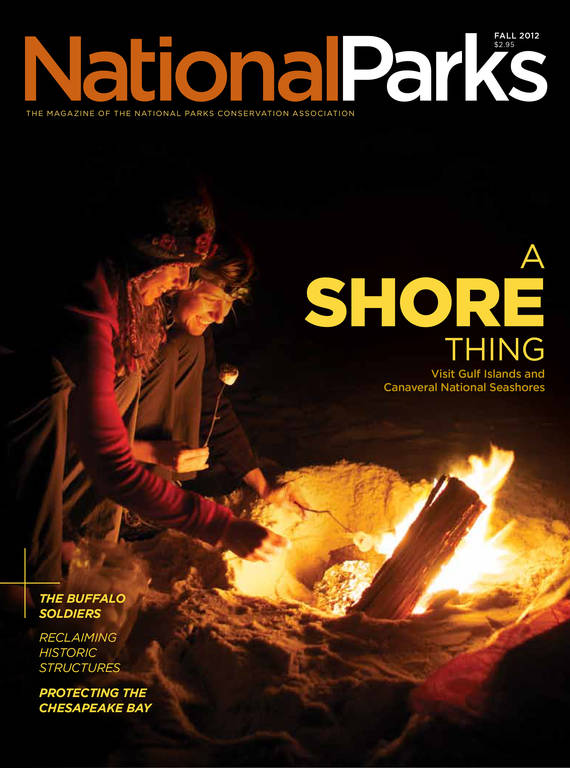Fall 2012
Rebuilding the Past
The National Park Service is finding new ways to preserve historic buildings that would otherwise crumble into disrepair.
The John Moulton Barn in Grand Teton National Park may be the most photographed barn in the world—with good reason. It sits in a sprawling meadow with unhindered views of the Tetons’ craggy tips. Although thousands of visitors appreciate the barn and the line of pioneer homes in nearby Mormon Row, few realize that many of the most recognizable buildings in national parks, such as these, are endangered.
Several years ago, the Chambers residence, one of the most beautiful old cabins on Mormon Row, had cracked windows, rotting window frames, decomposing logs, and foundation problems. Though the park was short on maintenance funds—a familiar story across the country—park staffers devised a creative solution. They enlisted the help of the nonprofit organization, HistoriCorps, which has now spent three years organizing volunteers for historic preservation projects on public lands.
The park provided funds to purchase materials, and HistoriCorps provided volunteer labor. Over three days, the crew shaped nine logs, hewed notches, restored the windows, lifted the building with 20-ton jacks, repaired the foundation, reset stones, installed gravel to prevent frost-heave damage (a result of the ground freezing and thawing repeatedly), and graded the site. But it wasn’t all work. In the evenings, they sat around a campfire, enjoyed hot meals prepared by the volunteer cook, and gazed at the Tetons, floodlit by the moon. The volunteers went home with memories of an iconic American landscape, and the Chambers residence is now bolstered to withstand the tough Wyoming elements—and thousands of camera-toting admirers.
LEARN MORE ABOUT HISTORICORPS
The Chambers residence is just one example of how the National Park Service is finding creative ways to maintain its historic buildings. According to the agency, there are some 9,600 historic buildings in the National Park System, and maintaining all of them would require $3 billion the agency simply doesn’t have.
The structures include sites like the Kennecott Mine in Wrangell-St. Elias National Park & Preserve, artists’ dune shacks in Cape Cod National Seashore, and railroad hotels like Yellowstone’s Old Faithful Inn. Many represent an important passage in American history and, without maintenance, are falling into irreversible disrepair.
“Some of these structures have been torn down or allowed to disintegrate,” says Dan Saxton, senior program coordinator for NPCA’s Center for Park Research. “With them goes the history of earlier settlers and early land uses before the park was established. These buildings help the stories of the parks come alive.”
In the past, Park Service staffers have been too overwhelmed by the maintenance backlog to devise comprehensive strategies for tackling it. But that’s starting to change. In fact, Saxton and his colleagues in Fort Collins, Colorado, are compiling a handbook to highlight creative ways the Park Service can bridge the maintenance gap, and that includes work the agency is already doing.
In 2005, the National Park Service and National Trust for Historic Preservation broke ground on the Western Center for Historic Preservation, in Moose, Wyoming. In 2006, a preservation shop and office facility opened up for year-round carpentry and administrative work. The White Grass Dude Ranch, which is being rehabilitated, will provide training in historic preservation techniques for maintenance employees of Western national parks. It is slated to open in 2016.
The founding of the center marked a turning point in the agency’s approach toward historic preservation. In the past, historic structures in parks that were established for their natural resources, such as Grand Teton, Yellowstone, and Denali, were often overlooked. Now, parks increasingly see these cultural assets as enhancements to visitor experience, and park employees are more committed to maintaining them. The trick, however, is figuring out how to bridge the funding gap.
In some cases, the Park Service collaborates with organizations like HistoriCorps, Student Conservation Association, and Youth Conservation Corps, which can provide volunteers and occasionally some historic preservation experience. In return, volunteers learn valuable job skills, such as log-cabin construction or window restoration, and often they emerge with a memorable experience.

National Parks
You can read this and other stories about history, nature, culture, art, conservation, travel, science and more in National Parks magazine. Your tax-deductible membership donation of $25 or more entitles…
See more ›“Invariably volunteers come back saying that this has been an incredible experience,” says Townsend “Towny” Anderson, technical director for HistoriCorps. “They take skills back to their communities, and they become advocates for historic preservation.” Other times, public-private partnerships help raise both money and volunteer enthusiasm for restoration projects. In one of the first, about ten years ago, the National Trust for Historic Preservation raised $800,000 and organized volunteers to help rehabilitate the historic McGraw Ranch in Rocky Mountain National Park. Now, the ranch is the Continental Divide Research Learning Center, an invaluable learning institution in the park.
The Park Service sees a number of purposes for restored structures, from storefronts for concessioners to housing for researchers, maintenance buildings, and even visitor centers. A series of historic homes in Delaware Water Gap National Recreation Area is now being used as artist housing, studios, and retail space at the Peters Valley Craft Center, which occupies the buildings for free in exchange for performing regular maintenance. In Acadia National Park, a private donation helped the Park Service transform a building on a U.S. naval base into a research and education center. And there are more on the way: HistoriCorps’ upcoming projects alone include rehabilitating historic log cabins in Arches National Park, a corral in Great Sand Dunes, and a patrol station in Grand Teton.
“Historic properties in the parks are vestiges of the past,” says Katherine Longfield, cultural resources specialist at Grand Teton National Park. “They teach us about where we came from and the people who lived here before. How do you know where you’re going as a community if you don’t know where you came from?” These historic buildings help us remember.
About the author
-
 Kate Siber Contributor
Kate Siber ContributorKate Siber, a freelance writer and correspondent for Outside magazine, is based in Durango, Colorado. Her writing has appeared in National Geographic Traveler and The New York Times. She is also the author of “National Parks of the U.S.A.,” a best-selling children’s book.



